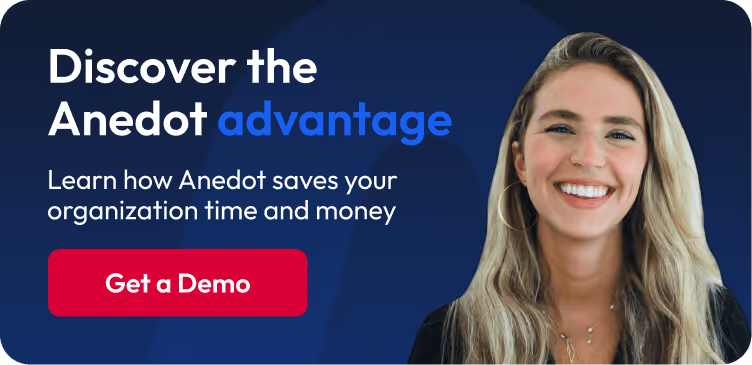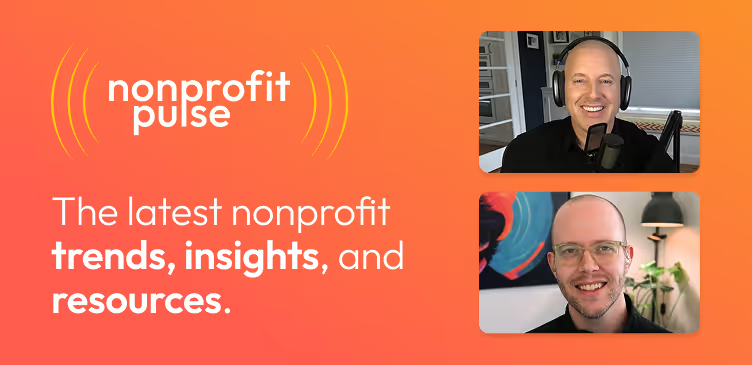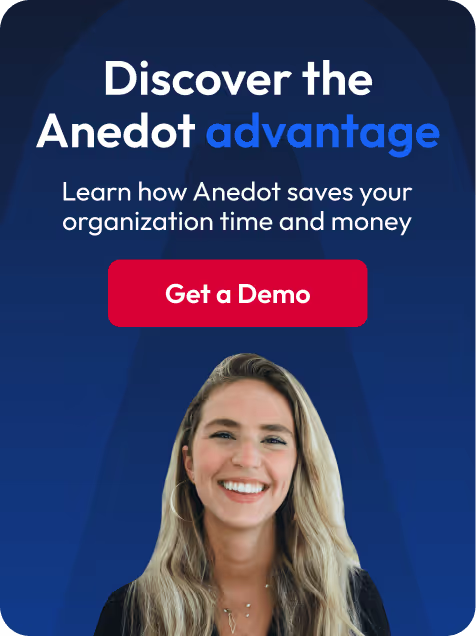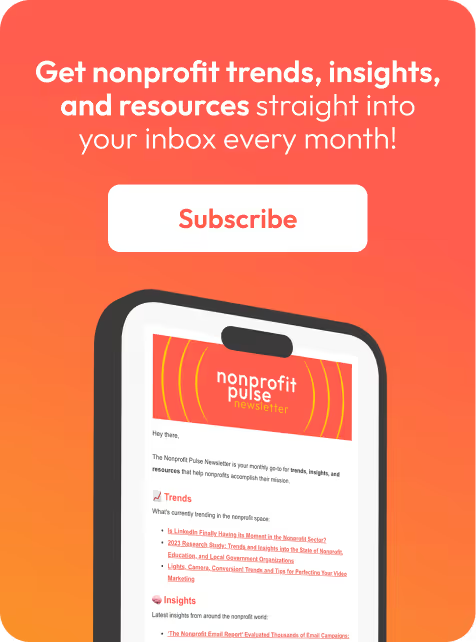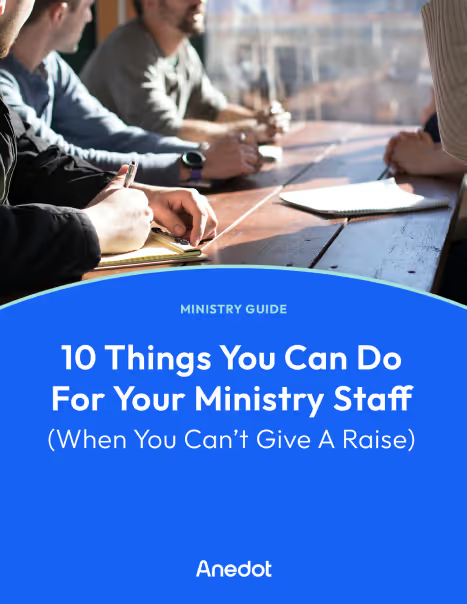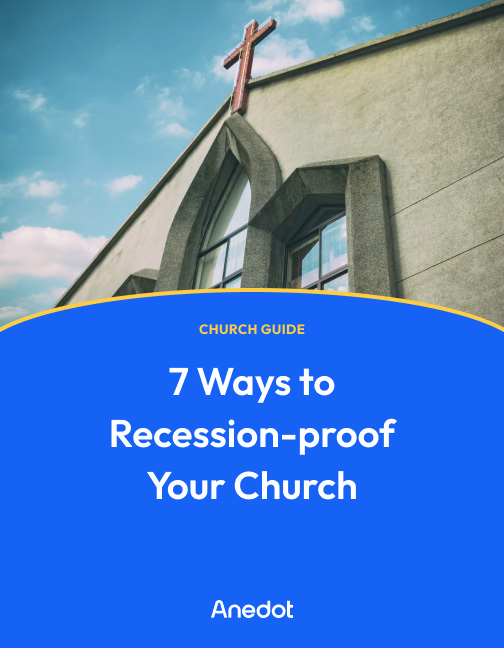Podcast episode transcript ↓
Josh:
Nonprofit capacity building is the cornerstone of organizational growth and sustainability.
By investing in capacity building, nonprofits can strengthen their infrastructure and expand their reach within the communities they serve.
So what are some practical steps nonprofits can take to initiate capacity building efforts?
I'm Josh with Anedot and welcome to Nonprofit Pulse where we explore trends, insights, and resources to help nonprofits accomplish their mission.
On this episode, we're joined by Kimberly Thornbury on the topic of the three pillars of nonprofit capacity building.
Kimberly is the Vice President of Nonprofit Leadership and Development at Murdock Trust, a foundation that provides grants and enrichment programs to community-focused organizations.
She has spent over 20 years as Vice President at two private colleges and has been a widely published author, frequent speaker, and organizational consultant.
Hey, Kimberly, thanks for joining us on the podcast.
Kimberly:
I'm so glad to be here Josh. Thanks for having me.
Josh:
Yeah, I'm so excited about today's topic because, you know, it's rare we get to talk with foundation leaders.
And, you know, we typically talk with nonprofit agency leaders or nonprofit leaders.
But now we have a foundation leader here with us and super excited about the perspective you're going to bring, which is going to be invaluable to our audience.
Today, we're talking about the three pillars of nonprofit capacity building, or just capacity.
So maybe just introduce the topic to us, Kimberly and let's start there.
Kimberly:
Absolutely. So, just first, I work at a foundation. We’re out here, near Portland, Oregon.
We will give over $100 million a year away. And we look for organizations with really strong skills or strong capacity. You don't want to fund, you know, a sinking ship, obviously.
And so, as we were looking through these grants time after time after time from nonprofit organizations, we found just weaknesses time and time again.
Most of them were in the areas of executive leadership, board governance, and fund development.
And we decided in addition to giving out grants, could we allot a little bit of our money to provide some programing to make the organizations stronger in these three areas.
And, you know, also, we could have done seven. There's organizations like McKinsey and Bridgespan that talk about like what are the essentials that a nonprofit has to have in order to be sustainable.
You know, they have to have a strategic plan. They have to be great at nonprofit storytelling. They need to understand finance and ops.
They need to have HR and recruiting. And that's a big one for nonprofits. You know, the recruitment and retention of their employees.
But you know, we can't do everything. And so we decided to stick to our knitting with programing in these three areas, and I can tell you a little bit about them.
Nonprofit capacity building pillar #1: leadership

Josh:
Yeah, yeah. Let's walk through them. So the first one is leadership.
So you know, at your organization, what do you look at when assessing the grant submissions when it comes to leadership? What are you guys looking for?
Kimberly:
Well, first of all, we never grant in somebody’s first year. So if you're an executive director (ED) and you're brand new and you're drowning, that's really normal.
And several foundations realize that. And, so for leadership, we look for a strong relationship with the board, somebody who can articulate the mission and the vision, who does have some financial acumen to keep the organization strong, with who understands how to read a balance sheet and, you know, P&L and everything like that.
But really understands the vision and understands how to measure where the organization is taking them.
One thing that I've learned about changing behavior with leadership is you cannot do it alone.
The board has the board and your staff has the staff. And the ED, like the cheese stands alone.
3 ways to grow in leadership
And what we have found is really effective is three things to really help a leader.
1. Suffering
One is suffering, which I don't think that the leader wants to go through.
But that really changes and makes a good leader stronger.
2. Executive coaching
And then two is executive coaching, if you can afford it.
Or maybe a mentor, say yes to that. And I know the ED leader is saying, what do I have time for in any given 60 hour a week?
Make time for that mentor, once or twice a month.
3. Peer cohorts
Peer cohorts are transformational.
And I don't know how you find a peer cohort in your area. We offer them for nonprofit leaders in the Pacific Northwest.
Those 10 to 12 people that are together with a master facilitator to talk about their hot topics, whether that's recruiting, whether that's an issue with the board chair, whether it's the fact that you want to crawl under a table every time you have to do a donor ask and you need advice. But that camaraderie.
And also we know that there's probably going to be burnout.
The studies show that, we're trying to avoid a moral failure with the burnout and a mentor or a peer cohort are two ways that can prevent that.
But I think in your leadership journey, at some point, maybe one of those could be part of your stew in becoming a better leader.
Josh:
Yeah. Yeah. It makes me think about employee engagement.
We just published an episode, last week, or a week before on nonprofit employee engagement.
And, you know, you mentioned, on the leadership side, kind of the health of the organization from the ED.
Do you all look at employee and retention rates and kind of the health of the overall staff when it comes to tenure and retention?
Kimberly:
Well, we don't look at that specifically. We do know when, you know, people are running through their director of developments.
But again, you know, director of developments last, you know, two years maybe on average. So that's kind of normal within the nonprofit sector. But yes, we also look at things like how well the staff are being paid.
So when they're asking for a grant or a position and they're not looking at comp studies of how much people are paid in the area, and they'll always say, and I bet you can guess it, it's low but we're a family, right?
We're a family here. It's a great culture. That's a big red flag, you know, to us.
And I get it. But also how to create sustainable nonprofits with employees who can sustain their family on a salary is something that we look for because they won't be able to stay if the mission isn't clear, if they're not being paid well and they don't understand the why of the organization. And the operations are kind of messy.
People are unclear about their roles and responsibilities.
Nonprofit capacity building pillar #2: governance

Josh:
Yeah. So let's move on to governance. Tell us what you all look at in governance.
We have an episode on on bylaws. I think last year, one of our first episodes, Greg McRay from Foundation Group talking through nonprofit bylaws, issues and I love that episode.
So talk to us about governance and what you all look at when assessing a nonprofit.
Kimberly:
When I was in college student development, I had my mentor. His name was David Dockery. He's now the President of Southwestern.
And while I was at Union, we survived like an F4, F5 tornado in 2008. Wiped out, you know, it hit 85% of our campus housing was gone and 23 buildings. I could talk a lot about that.
But fast forward five years ago when I was moving to New York City and I said, David Dockery, what is the thing you're most proud of?
And surely I thought he would say, recovering from this worst natural disaster. It was a lot of work.
Well, maybe he would say, you know, increasing students from like 1,300 to 5,000 students. Maybe it was the level of academic scholarship and the faculty and the books that were happening. Maybe it was the that that we expanded to Memphis, Nashville. We expanded internationally.
He said to me, Kimberly, I am telling you the thing I am most proud of is board recruitment, orientation, and development.
And at that time, I was like, that sounds super anti-climatic.
And he said, the truth is, Kimberly, nothing would have happened without a strong board.
Now that I'm on this side of it...
We do not see healthy organizations with a dysfunctional board.
4 characteristics of a healthy nonprofit board
And so, what are we looking for? I'll say maybe four things we're looking for.
1. The board understands governance
One, that the board understands governance.
That they have a board policy manual, that they understand how to run an efficient meeting, that they know how to recruit.
That they're not you know, you're not showing up at somebody’s gala for the first time and showing excitement, and then somebody asks you to be a board member by the end of the fundraising gala.
That they have processes, term limits, conflict of interest statements, that the governance is really healthy.
2. The board has a healthy culture
Two, we really look at the culture.
Everybody knows that famous Peter Drucker quote, “culture eats strategy for breakfast.” Right?
They can have a beautiful strategic plan. But the chairman of the board is talking to staff directly. You know, there's chaos.
There hasn't been an ED evaluation in five years. There's no term limits. Everybody's related to each other on the board. The culture is not great.
And, I mean, I would say I could stop, I will say the other two. But if you could get those two, everything will be transformational.
I serve on the board of my alma mater, Messiah University. It's in Pennsylvania. And, my mother passed away last week.
And you know what? I would say 80% of the board members wrote me a note, and took time.
And so do you like the mission? And do you really care about the people that you're serving with? It makes a difference if you want to show up and spend all that time with that person.
And, you know, if you're a nonprofit leader, find a way to feed them. Just find a way to feed them like at your board meetings. It makes just such a difference.
3. The board understands to have a sustainable organizational business model
So governance and culture, we also look at, does the board understand to have a sustainable organizational business model?
Are they looking at, not just the finances but your volunteer strategy, your facility strategy, your technology strategy, any internet, like program strategy you have.
And there's a couple ways to snow aboard. You can be at board meetings and give them, like one set of data, or you can give them like a 100 pieces of data and nobody reads it.
But the beautiful board, that board, it's just the right amount of data to make strategic decisions. Coming up with a board that is making data driven decisions is really important.
4. The board understands strategic planning
And then I would say a board that understands strategic planning.
And what we do is we kind of separate strategic from planning, because most people are so busy, they go right to planning in excel.
What do we want to do? Who's doing it? When are they doing like we get that kind of frenetic.
But a board that has taken time with the ED and with the staff to take a breath and to think about what they're good at, to imagine that stretch where they want to be, and what the landscape opportunities are.
Who their competitors are, who their target audience is and really, it's not brain surgery. You can ask yourself ten narrative questions to get to the strategy and then have like a plan that's living and ongoing.
But if they come to us with a project that is decoupled from a strategic plan, we often won't fund it because that's not how healthy organizations work.
Josh:
Yeah, I can definitely see that being a red flag that all of your planning and your activity was not birthed out of a strategic plan, but more of a we saw a need, we think we can meet that need, which is noble and good, but will that be successful or not is a different question.
Kimberly:
Yes. Yeah. And in terms of like meeting the need, with your data, oftentimes we'll have an organization maybe that is trying to get people to move from homelessness or houselessness however you determinate it, and they'll talk about how many they feed and lots of good data like that.
But that is not necessarily measuring what their mission is about.
I mean, it's good data, but data that really supports the ultimate mission of the organization. But measurement and evaluation is hard. It's scary.
And our next cohort is going to be about doing that. So you don't have to bring in an expensive cohort every three years to get your data right, to show all your funders and donors and vendors like it's actually doable with your current infrastructure.
You just need some capacity training to demystify how that's done.
Josh:
Yeah, that makes sense. And really, one more question before we move on to the fund development side.
When you talk about board governance and culture, I get the sense that a lot of nonprofits and boards as well struggle to really define what their culture is. And so when you're assessing, how often do you run into that where there's kind of, oh, we have a good culture.
Okay, tell me about your culture. Well, it's hard to define.
What would you say to those nonprofits who may be right now thinking, I believe in our culture, but I don't really know how to define it. How do I speak about it?
What does it look like? How has it evolved? Where is it going? Those types of questions.
So what would you say to those who struggle to define their board culture, or nonprofit culture?
Kimberly:
I think that maybe you could Google board culture survey, because it is interesting when they take that during our workshops and that brings up a lot of conversation where some people think the culture is here and the other one thinks, well, this is just insiders and outsiders, like the culture is good for you because you're the only four people that are ever talking at a board meeting and you never let us speak.
The coach actually in 30 minutes is pretty good about defining what that board culture is.
One of the things that we recommend is that the organization takes a board culture survey every year.
You can find it free online, and somebody will aggregate it. And then to just take some time in the board meeting to say, this is kind of what's coming up. you know, the board meetings that are always running late, we are not using a consent agenda.
And it's, you know, we are, maybe it's a faith based organization and that board has not prayed together in years, or it's just kind of a perfunctory prayer.
They're like holding on to things and not having a steward mentality at how the Lord is going to be guiding them. But honestly, just assessing your board with a survey every year is a great baseline to begin the conversation and then say it's worth it.
You know, what kind of culture do we want to have here?
I think it's worth the conversation in a board meeting or hopefully every year your board is doing an extended day retreat, even if it's like six hours in the board meeting. And that would be an agenda item.
Josh:
Yeah. That's helpful, that's helpful. And I'm glad that your workshops are also providing that and helping them walk through that because I do think it's a big issue or a big challenge when saying, hey assess us for this grant or this opportunity and knowing that, oh we've got not necessarily cultural issues, but we just don't even know how to define our culture or control our culture.
Defend it right, from becoming something we don't want it to be. So I think that's super helpful.
Kimberly:
Yeah. And one of the things that we talk about is your culture can change.
For example, if you're a small startup, your board is going to be a working board and they're going to be way more involved, and that's okay at that inflection point.
But as the organization grows, as you get new staff and new strategy, your board probably will live from like a governing, a working board to a board of directors to sort of governing or advising.
And so the culture and the responsibilities of the board will look different over time. And so it's helpful to check in and say, you know, where are we as a board?
And so what do we want to look like? Because it is not static, because your organization is growing.
Nonprofit capacity building pillar #3: fund development

Josh:
So thinking through the third pillar Kimberly, we're headed to fund development. So talk to us about this area.
What do you all look at when it comes to funds? Revenue, diversity in revenue? You know, what all do you look at?
Kimberly:
Yeah. I mean, that's the biggie, right? I think I think fund development, HR and recruitment and retention, and nonprofit finance and technology are like the three biggies, you know, but fund development, it's hard. Right?
I think the new term that's emerging is resource development to be like well contributed income or earned income. But you know, we want to make sure that the funding plan, especially with faith based organizations, you know, what's that blank line item?
And they’ll say, well that line item is for the Lord to work. And while I as a believer, I'm so excited for that. We also need to see some best practices.
So a lot of organizations like their donors are on a little piece of paper. Okay, are we using software for the donor?
And so of course, what are you raising money for? The board and the ED and the staff have to have a strategic plan, like where are we going? And then, you know, do you have a segmented donor list?
You might hear, well you know what, if everyone on our list would just give us $25 we'd be fine. Red flag.
But that's not how development works. You have the people that can give here and here and here.
So do you even understand what a tiered donor strategy is for your donor?
And how are you thanking them? And people give when they know when they're asked and people just say, oh, I you know, don't they just know we need money?
We're a nonprofit, right? Are you asking? Who are you asking? How are you asking?
And do you have a case statement and actually, like, physical, like a piece of paper that says what your vision is and what you're asking for.
And literally is the address and email and phone number on there so they know how to give?
It's so funny how many nonprofits make it super hard to give. It’s like, who do I contact?
And then we talk about the pros and cons of the gala, you know, that are so much work for your staff. And what's the ROI on that?
But we know that most giving is done by individuals, and it's such a joy for them, but they need to know what they're giving to, that they're thanked properly, that there's a development planning team, that there's software for development that's keeping things in order.
And again, we realize that it is hard to ask for money. And so we do a lot of case studies and like role play in what we teach to, you know, and also don't go over somebody's house unannounced or say you're coming over for coffee and then come for a big ask like, that's a big red flag.
Tell the person that you're going to meet to talk to them about this.
So these are some of the practical things that we would teach in fund development that some people of the organization might know, but everyone needs to know it.
So it can be a culture of how we raise money for this organization. And it's done according to the best practices.
You know what I'm gonna tell you? It's possible. So if this is a weakness and you get with a training or a coach. I'm telling you, most of the time it's going to knock your socks off.
You will absolutely raise more money if you do it yourself. This is a learnable skill and I know it. And take time to do that capacity building and fund development.
Josh:
Yeah. And we see that so often at Anedot.
Anedot, we're an online giving platform for nonprofits, churches, ministries, education, and political campaigns and we see it in our nonprofit customers.
We see a really a lack of maturity in their fundraising efforts, as well as their operations, which are very much related to each other.
And, you know, it's really an exciting area to think about if you're a nonprofit leader is, yes, how in 2024 are we going to mature our fundraising efforts?
And even thinking beyond that, right, thinking, okay, in the next 4 or 5 years, where do we want to be when it comes to the maturity of our fundraising efforts?
And I think most nonprofits just struggle to even have that conversation, because you know there's always another need. There's always payroll hitting, there's always another fire to put out.
And we see that across the board from small nonprofits, which would be expected, even to larger nonprofits who are really struggling to mature their nonprofit fundraising efforts.
So for those in our audience who want to do that, who want to say, look, I would love to have a 4 or 5 year plan of how we get to a more mature fundraising operation.
What would you encourage them with Kimberly?
Kimberly:
Well, if you're in the Pacific Northwest, you can call me. Or even if you're not, you can call me and I can sort of eharmony you to some vendors that I think are great.
One of the things that I would recommend is that if you're an ED to not do this training alone, because you do this training and then it's a weight of things that you have to do, and then you have to re-explain it to someone. And I know you don't have the energy for that.
So if you are thinking about training and you can contact me and I can, you know, think about your area or your sector, there's some sector specific trainings that are interesting, is to say we're going to commit to me and a staff like the ED and a staff and maybe one board member who's going to go through this together, we're going to get a common language, we're going to work on the calendar together and the systems.
It's going to be fun because you’re in your little cohort.
Learning is best over time in a team and preferably with a coach to help customize it with you. It is worth it.
And because you're thinking as an ED, what am I going to put money into and time into that's going to have the highest ROI?
And I'm telling you, fund development is. And look, if a book changed your life, I’d give you a book recommendation right now. Like, obviously I love books. Going through my books right now.
I just don't think that is how executive directors of nonprofits learn, because they're busy. So they may or may not get to that book.
Executive directors need some accountability with a cohort or a coach or a program that's going to take them over time to learn how to make a mature strategy, as you said. But don't go it alone.
Closing thoughts

Josh:
I love that, I love that. One question we ask on every episode, Kimberly, is if you were on stage in front of a thousand nonprofit leaders, which is a very comfortable place for you, you're quite often on stages.
If you're on the stage though, and you had the opportunity to share one thing, one sentence, about our topic today, which is capacity building for nonprofits, what would you say?
Kimberly:
This is the most recent thing I would say: just do your worst.
Because I think in some of these, like a mature development plan or a mature fund development and, you know, perfectionism leads to procrastination, leads to paralyzation, we know.
It does not have to be beautiful or perfect. I'm asking you to do your worst, which might be investigating it for 20 minutes next week. The worst.
Because I understand the pressures. But just like giving yourself the lower bar, maybe that is counterintuitive, might help unfreeze you from some perfectionism and help take the next step into some of these healthy practices.
You can do it. You were called to it. You were called, and you will be equipped and you will get there. But I want you to have a team around you, you know, in order to flourish.
Josh:
I love that, I love that.
Take the next step, even if the bar is lower than you're comfortable with, just take the next step.
Kimberly:
Yes. Absolutely.
Josh:
Awesome. Kimberly, any resources that you would recommend to our audience?
Kimberly:
I mean, I think that you can contact me because, again, depending on your sector, for fund development, we use The FOCUS Group in Florida, and they're wonderful.
And then we work with a team of coaches in board leadership that would be happy to help you. And you could throw a rock and find executive leadership cohorts.
But we are very aware of our power not to recommend.
And so maybe part of your like 15 minutes next week is to call five leaders you respect and say, did you ever have an executive coach or were you ever in an executive cohort, the three C leaders or you know, and was it a good experience for you?
The best come from talking to your peers.
Plus, you should be a collaborative executive director anyway, and just pick up the phone and say, hey, so-and-so, I have a seven minute question for you, because you should also be in the habit of calling other EDs every week to check on them, encourage them. Can be four minutes, it can be seven minutes.
That's a great question for your calls over the next month is capacity building or leadership programs that have been great for them, even if they do not give you an answer.
You are being a great leader by having a generous spirit and being for somebody else.
Josh:
I love that and this whole conversation has been so helpful, and I hope our audience gains a lot from it.
Kimberly, thanks so much for joining us.
Kimberly:
Thank you so much. God bless you. Thank you.
Josh:
Thank you.
Hey, thanks for listening.
If you enjoyed this conversation, please share or leave us a rating and review wherever you listen to podcasts.
Also, head on over to Nonprofitpulse.com to sign up for our monthly newsletter, as well as check out all the links and resources in the show notes. We’ll see you next time.
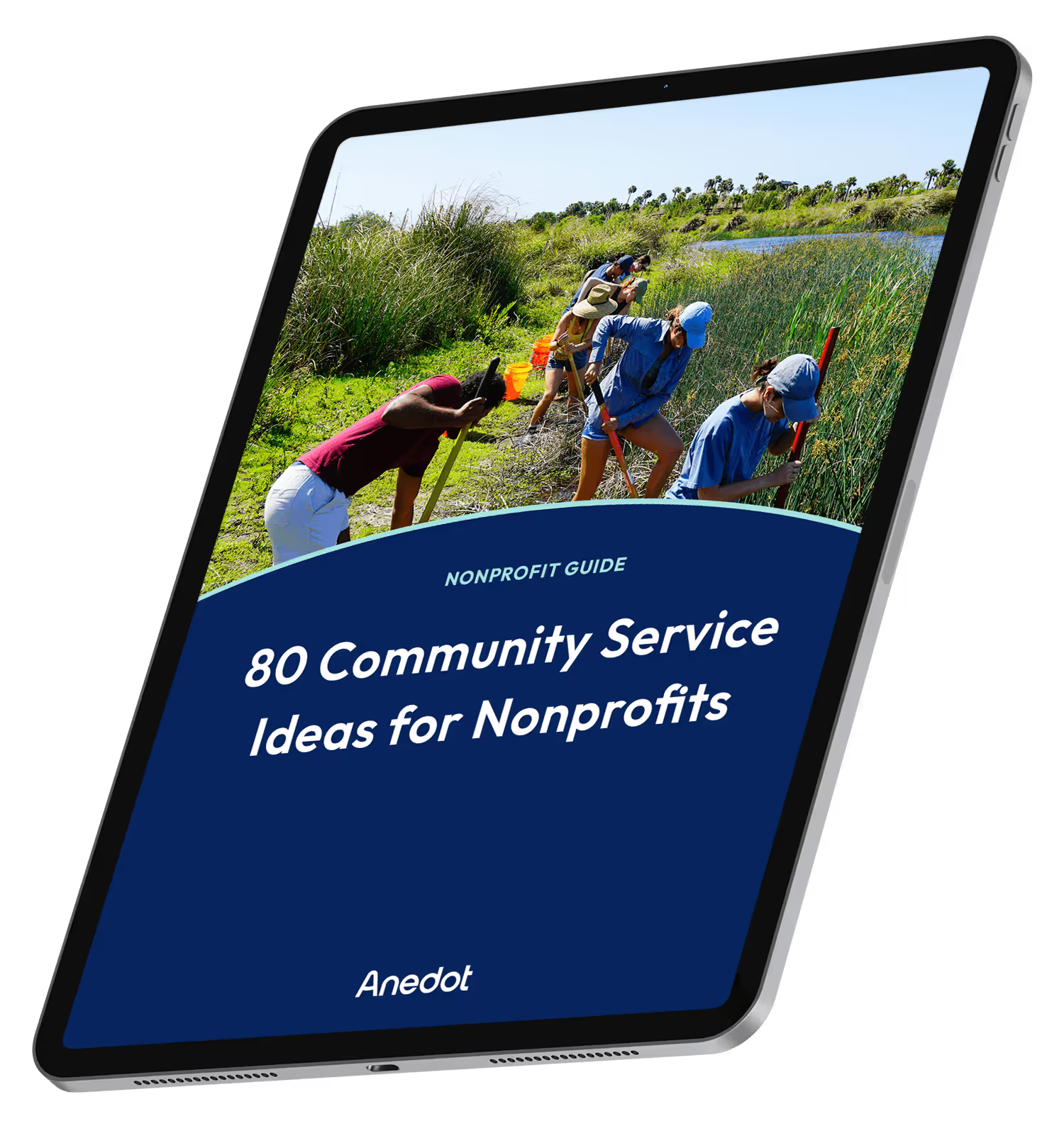
80 Community Service Ideas for Nonprofits
